Professional Player Development: Crowd-Sourced Edition!
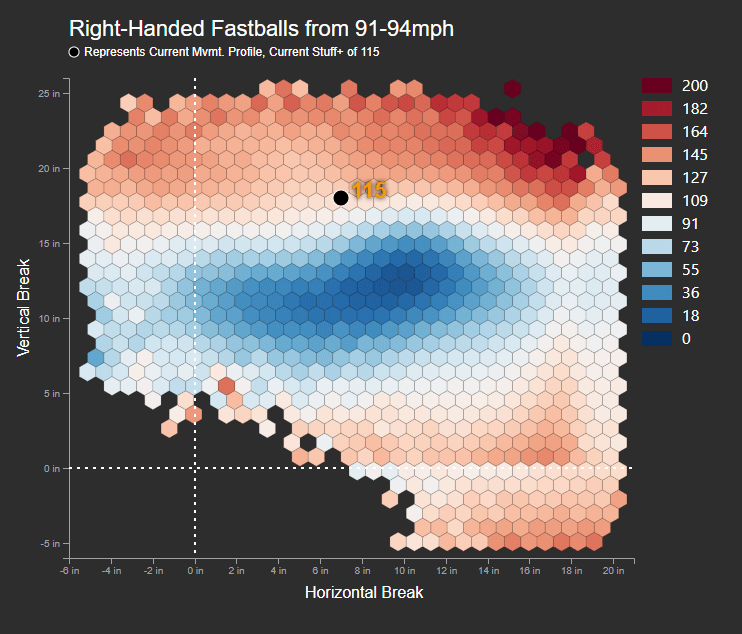
On Twitter (@drivelinebases), I posted a thread with some polls about professional player development and scouting with some options – and got tons of responses! In this blog post, we’ll go over them with my opinion on each question, select key tweets from respondents who elaborated on their answers, and perhaps come up with some new questions for the next edition!
(My Twitter account auto-deletes tweets after some amount of time, so all tweets here are images clipped and posted.)
Do Team Wins Matter in the Minor Leagues?
This is the question that kicked it all off:
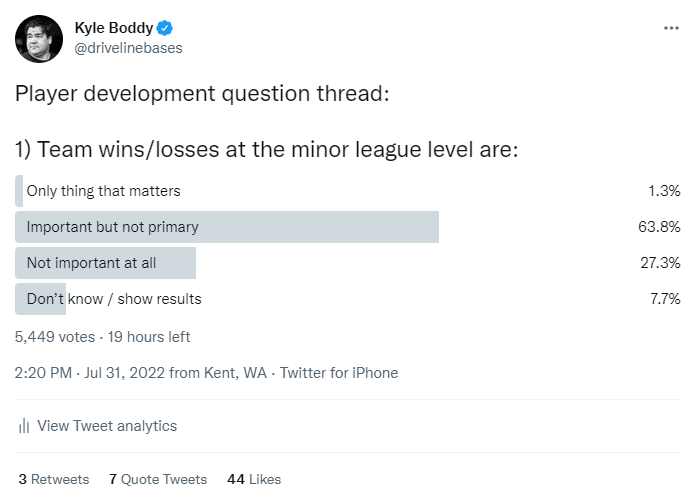
In many professional organizations, the mantra that is literally repeated around the clubhouse and front office are:
“Wins at the minor league level do not matter – only player development matters.”
Some organizations will go so far as to say things like:
“We will never put winning above developing players.”
On its face, this makes a lot of sense – after all, the goal of the minor league systems for professional baseball is to develop their players, not necessarily win games. A trophy at Double-A doesn’t confer 2 extra wins in the big leagues, after all.
I think the majority opinion around professional baseball is a more balanced approach, where they care a little bit about minor league wins/losses, but not a whole lot. 63.8% of Twitter respondents out of 5,449 votes are in or around that bucket, with 27.3% saying that wins/losses don’t matter at all. I would say this is likely close to the split of MLB organizations’ opinions, with the devil in the details of the “Important but not primary” answer – which, for the record, is also my answer.
But as stated above, the devil truly is in the details. How important is “important but not primary?” When I was the Director of Pitching of the Cincinnati Reds, the organization cared a great deal about winning in the minor leagues, which I actually agreed with. They didn’t put it above everything, but the win/loss records mattered to them. And win we did, posting the best winning percentage in the minor leagues since 2006, and the first time over .500 in a decade.
This made me proud, because while winning is indeed a byproduct of development of your players – and our pitchers saw incredible gains from 2019-2021 – I truly believe that winning itself is an intrinsic skill. I’ve discussed this with a number of professional players and front office executives, and the easiest way to sum up what I believe about winning in the minor leagues is that winning is the only thing that matters at the big league level, and not caring about it at any level before that is setting a player up for failure – especially on a winning team.
Furthermore, many Twitter responders pointed out something relevant: It’s simply not fun to play on a losing team, knowing you’re going to show up and get your ass kicked on a daily basis. A culture of winning breeds a more friendly workplace, and makes it easier to put in that extra work for your career and the team’s benefit. It helps the coaches hold players accountable on a regular basis, and sharpens the small things in the game that get amplified on the largest stage.
Grade: Important but not primary – I agree with the Twitter poll, but lean more towards winning than I think most do.
Do Non-Prospects Matter?
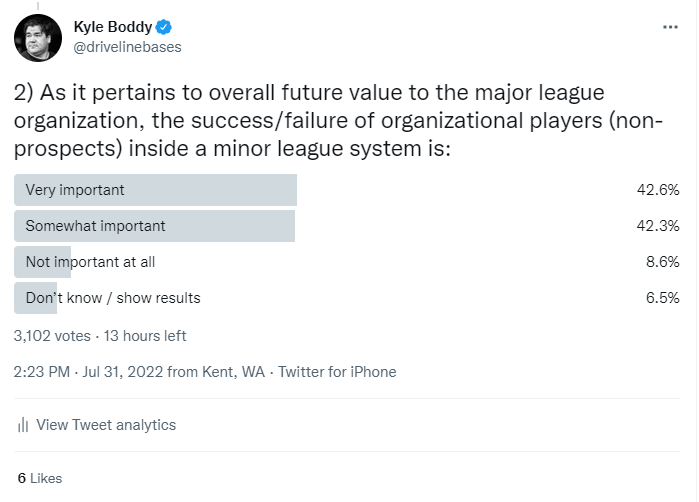
What a race! With 3,102 votes in, the vote was essentially split amongst the Very Important and Somewhat Important poll options, with Very Important barely squeaking out the win. I was surprised at the large number of people saying “Not important at all” with 8.6%, which seems clearly incorrect.
Let me give you an example of a minor league pitcher who was/is a “non-prospect,” or “organizational player,” and his journey so far inside professional baseball. This player was a low-bonus signee who was considered to have good command but not much stuff – both the analytics and scouting department agreed with that assessment before signing the player. His fastball had a Stuff+ rating of 36, which means it was 64% worse than an average MLB fastball – seen below on The Blob tool from Driveline EDGE/TRAQ:
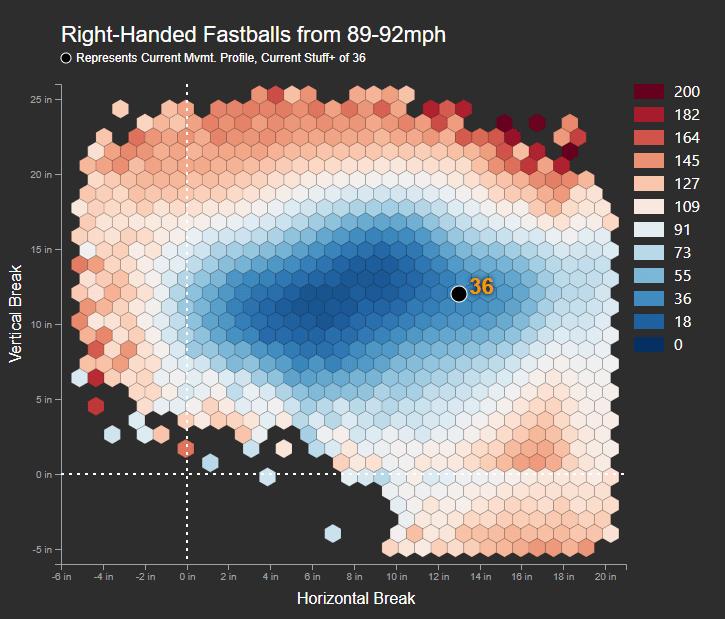
The pitcher’s other pitches weren’t too good either, so something had to improve, starting with his fastball – he needed to throw harder, yes, but he also needed to get his fastball out of the “dead zone,” which is where you have equal parts carry and run with small-to-mediocre values of both (some dead zone fastballs that have high velocity and lots of movement can be nasty, but that’s not the case here).
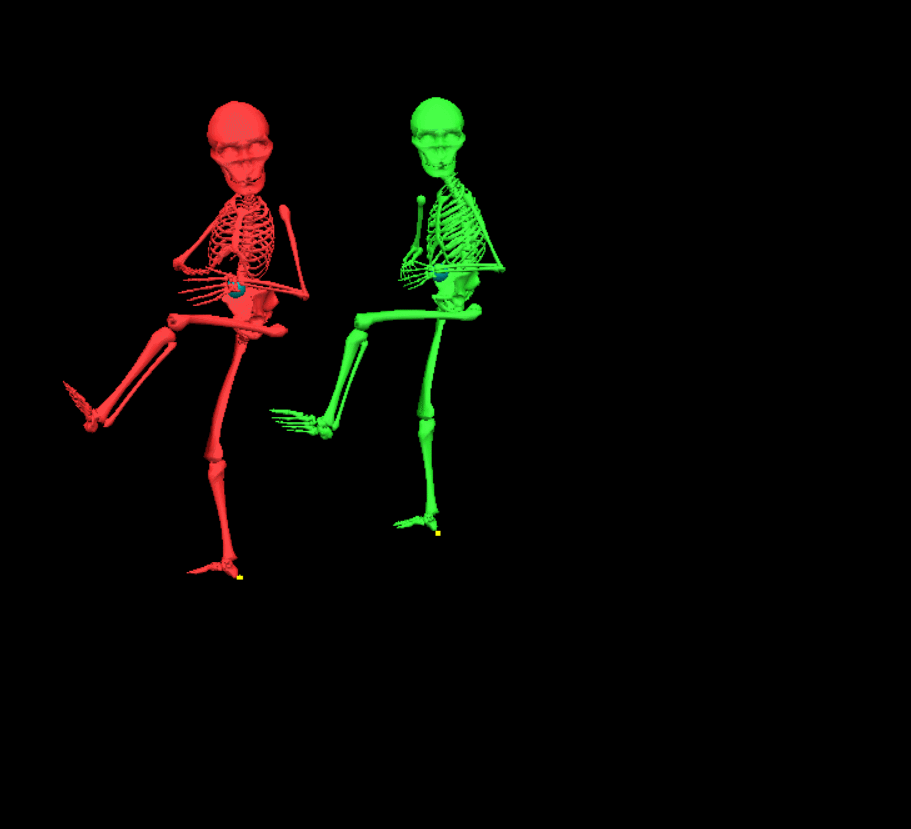
Get more content like this
Only on Driveline PLUS
In most organizations, this pitcher would be sent out to fill innings, get shelled, and maybe reach Double-A as nothing more than someone who helps get through innings by throwing strikes. This is the fate of the organizational player – someone who is simply there so the prospects can play.
However, in this player’s case, upon signing, he entered a specific development program with the intent of improving his pitches while being held out of competition. The following year, the player had significantly improved his fastball velocity and drastically improved its shape. Once again, we’ll consult The Blob, which is what we use on a daily basis with our professional pitchers in-gym (and remote) to explain the roadmap to major league plus pitches:

Wow! His new fastball has a more four-seam true profile, with above-average carry. It’s also two ticks faster, and combined with the better ride on the pitch, has granted it a Stuff+ rating of 115, making it 15% better than a major league-average fastball, an absolute improvement of 79 Stuff+ points in a half of a season + off-season of work.
This player also developed two breaking balls that had Stuff+ ratings of about 100 each, plus a slightly below-average changeup, meaning he had one above-average major league pitch, two average major league pitches, and one slightly below-average major league pitch – with plus command from a low bonus signee.
The average draft position for a college pitcher with average major league command and three average-or-better pitches is likely in the top five rounds – meaning the organization basically got a player in the top 180 picks in exchange for a very low signing bonus and a back-end draft pick (or in his case, a non-drafted selection, meaning no pick was even needed).
Unfortunately, in 2022, this player has seen significant regression in his Stuff+ grades due to inconsistent coaching in his professional organization and outside facility training, leading to his fastball to tick down to average due to losing some carry and his hard breaking ball to turn into a sweepless cutter-type pitch, making it a tweener and one that The Blob does not particularly favor:
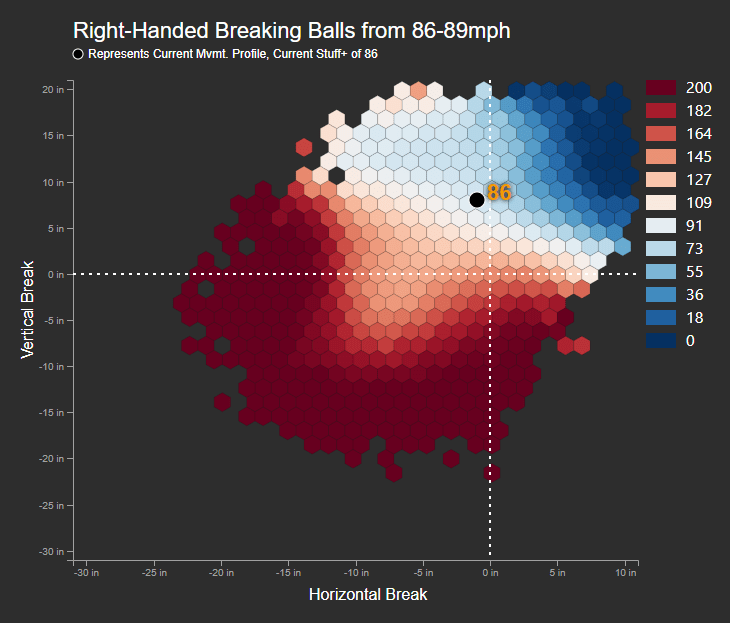
That’s not going to cut it (pun unintended) – this is about 20 points worse by Stuff+ than his previous equivalent breaking ball in this slot.
In a nutshell, that is the yin and yang of an organizational player – the journey from an innings filler to potential player with major league value, back on the road to a potential innings filler once again due to inconsistent player development and coaching.
So, what’s the conclusion? There’s room for a lot of opinions on the topic, even with the data above, but I say…
Grade: Very Important – I agree with the Twitter poll.
Scouting or Player Development? Beer, or Tacos?
Asking if you want the best scouting or player development is a lot like asking: Do you like beer or tacos? The answer, of course, being: Both, you fool.
In this case, however, I made people choose:
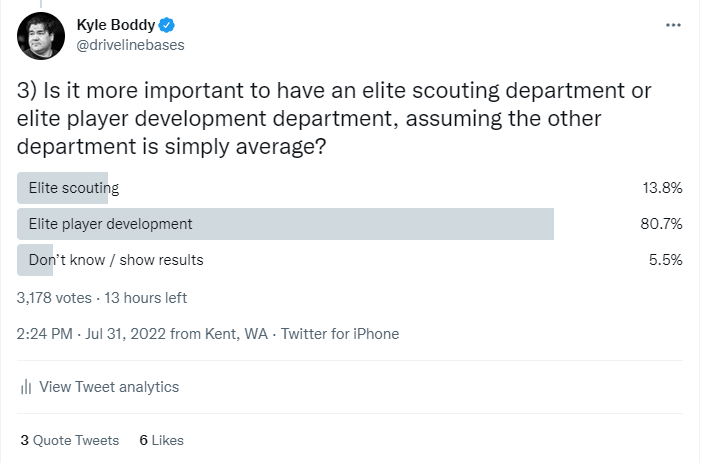
A whopping 80.7% majority voted for “Elite player development,” which surprised me – though perhaps it shouldn’t, considering that most people associate me with player development (even though I got my start in scouting!) and most of my followers are probably either coaches or players and thus more closely related to player development over scouting.
When I made this poll, I wasn’t quite sure what answer I was going to go with, but I leaned towards voting for “Elite scouting,” which I am sure surprises many of you. However, after examining the question a bit more in-depth, I started to change my mind – so I’ll take you through that process.
Quantified Aspects of Players Carries Strong Signal
This is generally bad for traditional scouts – technologies like Trackman, Hawkeye, Rapsodo, Blast Motion, Diamond Kinetics, TRAQ, markerless biomechanics, and so forth carry significant signal on how good a player’s tools are. As such, traditional scouts’ eyes are devalued for populations where you can draw this data from – namely, college players – and also increasingly elite prep players playing at showcases where this data is collected, in addition to the new MLB Combine.
However, there are areas where this data is unavailable – most people think international prospects, but even there you’re getting more data to put into scouting models than you’d expect, even if data on 14-15 year old players is specious at best. No, the value of traditional scouts goes way up in areas like Junior College and lesser-known high school players, where their eyes are the only source of information available. Once again, though, there’s an issue – the MLB Draft was shortened to 20 rounds, meaning there are less opportunities to sign back-end type talents, especially since domestic minor league roster spots are now limited.
Are the best scouts way better than the median scout? Absolutely, and this carries a ton of value – especially veteran scouts who build relationships with local players, coaches, and trainers to uncover intangible aspects of players that no technology can capture. However, this signal gets eroded by draft models and increasingly available quantifiable data.
Does this apply to player development?
Player Development is Still Too Fractured
In professional organizations, player development departments are still highly fractured – there is strong resistance in most organizations to unify under a data-driven message and run the department like a real business. Well-run organizations of all sorts take from principles found in High Output Management, The Hard Thing About Hard Things, Good to Great, and other well-regarded business books. Running a player development department has discrete inputs and outputs, and pretending otherwise doesn’t make it true – indeed, with increased quantification of player performance at the process level (rather than simply results level), managing via Key Performance Indicators and other metrics has never been more valuable.
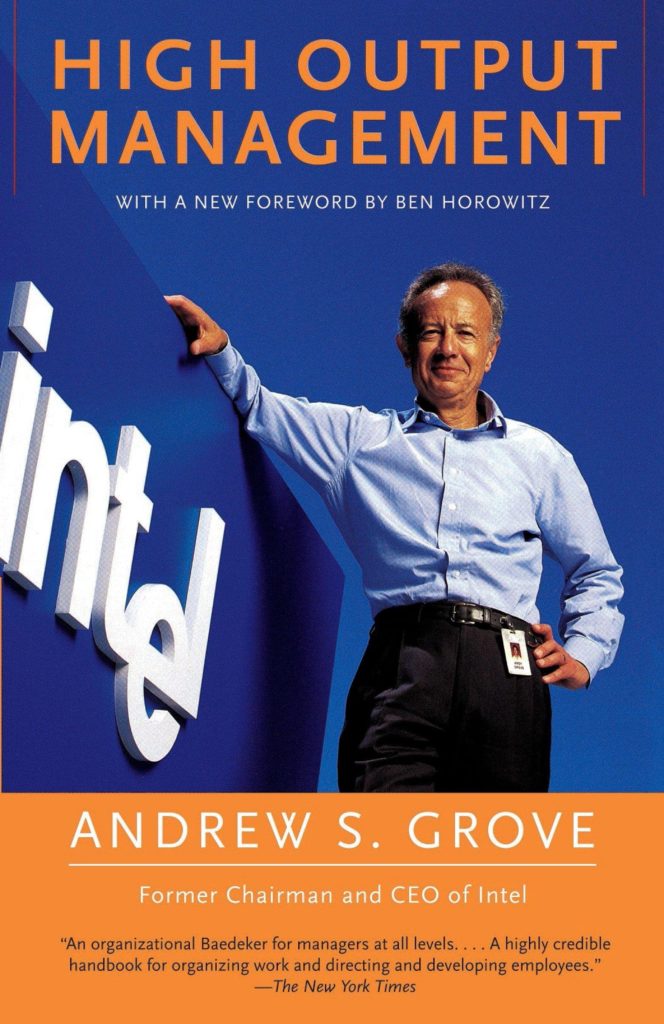
Unfortunately, the majority of organizations reject this concept, believing that baseball is somehow immune to the forces that govern almost all other businesses and organizations worldwide. This simply isn’t true, as the organizations that consistently outproduce homegrown talent – either for their roster or for trading – have well-defined and accurate processes, strong cultures that truly lead the organization, and managers/directors with the will to enforce the culture in both gentle and harsh ways, if necessary.
Conclusion
I believe that the difference between an elite scouting department and a median scouting department is smaller than the difference between an elite player development department and a median player development department, therefore…
Grade: I would prefer an Elite player development department – I agree with the Twitter poll after changing my mind.
Stuff or Command?
I knew this question was going to be a doozy…
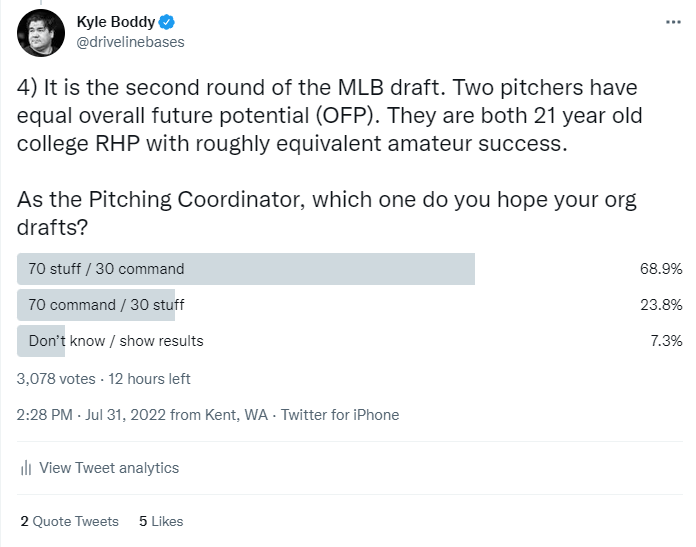
I’ll be the first to admit I probably should have gone with the third or fourth round here over the second round, but it doesn’t change the soul of the question: Do you want elite stuff or elite command from your top draft picks?
Kyle Wasserberger from Driveline said:
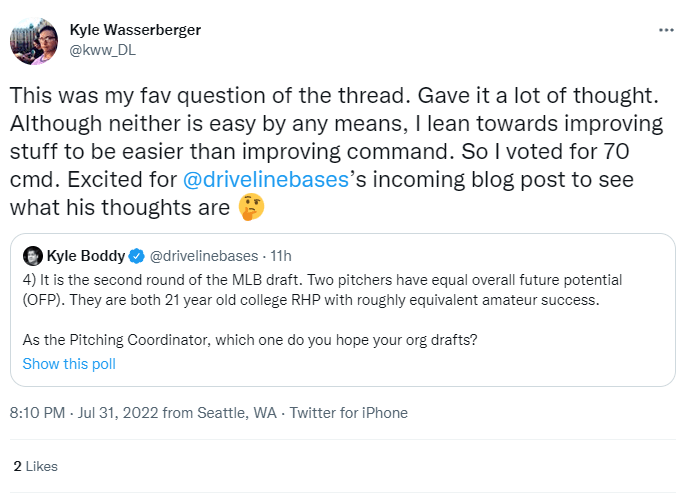
I agree with the base of his answer – it’s generally easier to improve “stuff” over “command” given everything we know. However, it is not a given, and as one major league pitcher allegedly said:
“Command without stuff is batting practice.”
Spencer Strider, Atlanta Braves
Ultimately it comes down to scarcity, and a 70 grade on Stuff is no joke – hard to find, even harder to develop. This is also true about 70 command, but if we scroll up to the question about Non-Prospects, you’ll see that pitchers with plus command are available later in the draft and even in the non-drafted pool. At the end of the day it’s about value for what you’re paying for, and it’s simply easier to find better command and low stuff in the later rounds of the draft than vice versa, meaning you should pay the premium for elite stuff, not command.
If neither player gets better, the pitcher with 70 stuff has a chance to pitch in the bullpen for your major league organization, and likely still retains trade value even if he doesn’t have the best performance statistics in the minor leagues. However, few organizations will trade anything of value for a 70 command pitcher with below-average stuff, making the decision…
Grade: Give me the pitcher with 70 Stuff / 30 Command – I agree with the Twitter poll.
Force Plates or Biomechanics?
What I had as a bit of a throwaway question ended up becoming one of the more interesting ones in the thread:
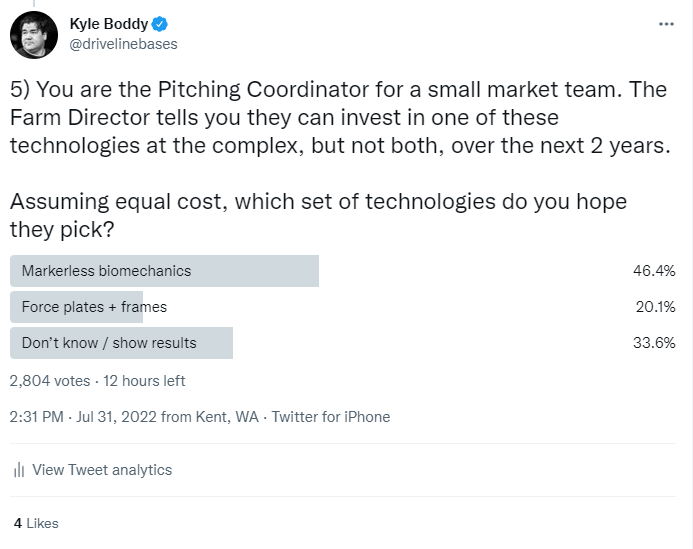
For this question, I’m going to outsource my answer to @Tieran711 on Twitter, whose response I very much agree with:
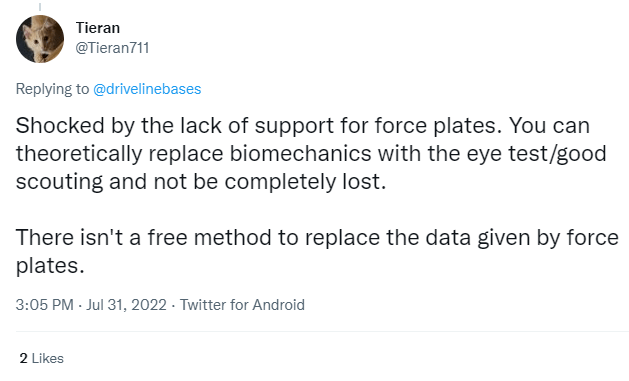
I’m sure most people expected me to vote for markerless biomechanics, and while that’s technology I’d be more than happy to have, I strongly believe that we could replace that with lower cost methods (and manual inspection of high-speed video) much easier than we could replace higher resolution data from the weight room in the form of force plates and force frames (ways to measure upper body isometrics/positions). At Driveline Baseball, our High Performance team gets surprisingly strong signal from what we call the “HP Dashboard,” which has our aggregated strength and power metrics in it, many derived from force plates and force frame-type devices.
It has become immeasurably important for our pitching coaches, and forms the foundation of the athletic programming we give our trainees to build a complete player.
Take a look at these two professional pitchers – one of them clearly dominates the spectrum of the High Performance metrics we have (we don’t have a cluster for this, he’s just elite-elite), while the other dominates the power portions, but has low marks in other areas (Cluster 2: High Power, Low Else):
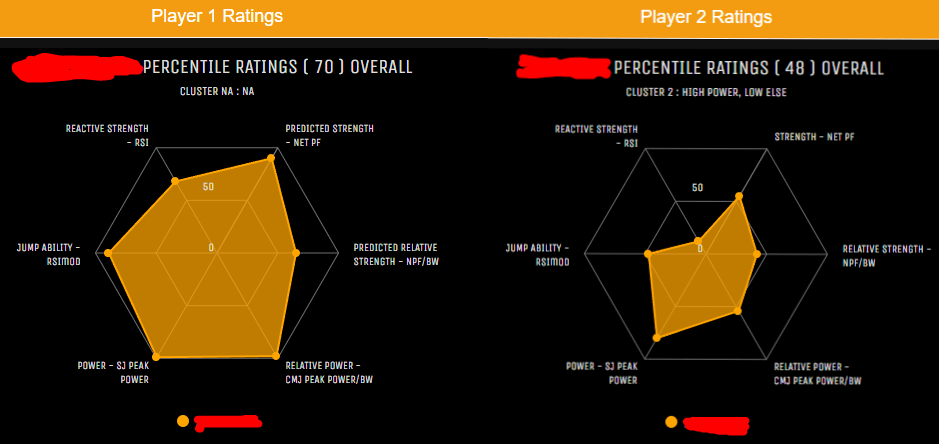
Without knowing anything about their biomechanical signatures, which one do you think throws absolute gas? Right, Player 1. Player 2 is still a very good professional pitcher, but he’s not Player 1. And even if Player 2 was the better player, Player 1 has the higher ceiling to unlock via more advanced methods you’d discover via biomechanical systems.
So…
Grade: Force plates + force frames – I disagree with the Twitter poll.
Genie Time: To Do a Velo Program or Not?
The question you all knew was coming….
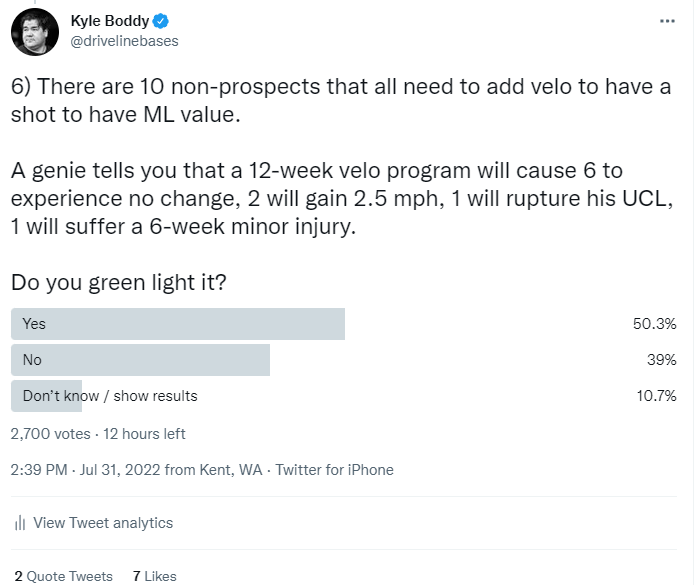
@HarrisFreePress on Twitter said that I inadvertently created the baseball trolley problem, so I whipped up this meme:
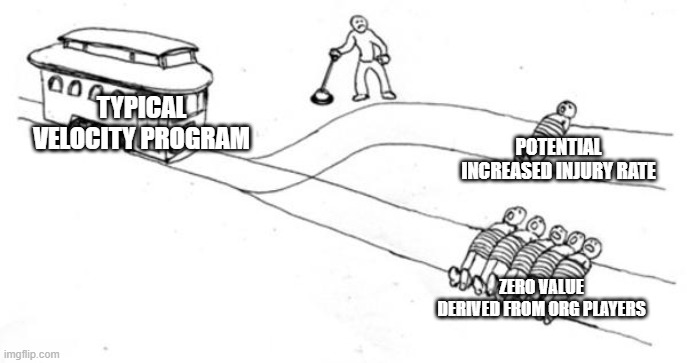
I’m gonna cut straight to the chase on this question: It’s not close, the answer is Yes.
The canonical study done on this topic about gaining fastball velocity comes from Mike Fast from The Hardball Times in Gain a Tick, Lose a Tick. His conclusion:
Being able to bring the heat is a very important factor in a pitcher’s success. Being able to crank it up a notch typically improves a pitcher’s run prevention abilities, and losing a notch hurts his effectiveness. Starting pitchers improve by about one run allowed per nine innings for every gain of 4 mph, and relief pitchers improve by about one run per nine innings for every gain of 2.5 mph.
Mike Fast, The Hardball Times
In 2014, Jeff Zimmerman replicated the findings in his post on Fangraphs.
Finally, in 2019, Dan Aucoin looked into it at Driveline Baseball and – surprise, surprise – found the same results in his blog post The Value in Developing Fastball Velocity in the Minors.
The idea in this exercise is simple; we controlled for changing run environments on a year-to-year basis and found the difference between projected FBv and actual FBv (min 50 IP) as well as projected RA9 and actual RA9 for each individual pitcher at the MLB level. We expected that a pitcher who threw his fastball slower than expected in a given season would have worse outcomes than previously projected, and vice versa.
This relationship is exactly what we found over a sample of 1,838 athletes. More specifically, a pitcher who outperformed his fastball velocity projection by +1 mph produced an RA9 that was .2443 points lower than expected, on average.
Dan Aucoin, Driveline Baseball
The following chart illustrates the magnitude of the gain/loss:
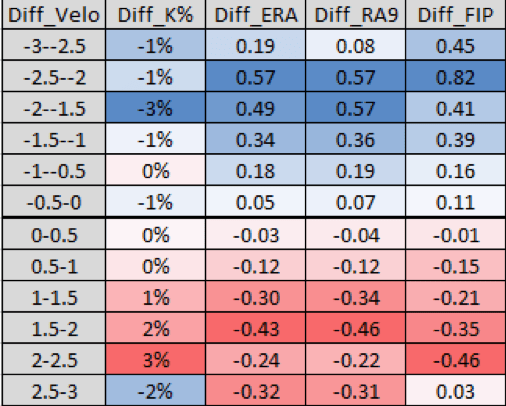
There’s really no debate: Throwing harder than you’re expected to throw makes you a better pitcher.
Of course, that’s not the question, is it? The question revolves around the injury cases I put into the poll to make you think about it. Let’s start with how you’d ethically roll out such a program, first and foremost. You could not force minor league pitchers to take part in this program – at least, I wouldn’t do it – and as such, you have to disclose all the benefits, risks, known unknowns, and options to them ahead of time. You would tell the group of ten players everything you knew about the program, everything you know you don’t know, and things you think you might know that you don’t know, and present them with the option to sign up for the program or not.
The issue, of course, is that if they don’t sign up for the program, you have very, very strong confidence that these non-prospects are Role 0/1 players, which is a nice way of saying that they have no chance to provide major league value to the organization in any form. As such, the alternative to the program is to fill innings, or more likely, get outright released. This is also something you should disclose to the players – an honest evaluation of their present abilities and their projected inability to provide value to the major league organization.
Now, from the Pitching Coordinator and front office’s point of view, this program clearly has a lot of benefit. Two pitchers gain 2.5 MPH, which is not insignificant, one player has a minor setback, one player requires team-paid surgery on his elbow as a result of the program, and six remain in the same spot as they were before. Ideally you’d get better results, which is what many people on Twitter asked for, but that’s not answering the question – and this question indeed has a very simple answer, which is that yes, the front office should want this program to go into effect.
A 10% chance to rupture your UCL is probably quite close to minor league average “major surgery” rates, which is one of the first things you should evaluate. Therefore, how much additional risk is this program really adding? Likely, not much.
Next, all the data and information above clearly shows how valuable adding 2.5 MPH on a fastball can be for pitchers – especially if they’re in the mediocre threshold, like most non-prospects are.
Last, this scenario was not entirely hypothetical – Driveline Baseball rolled out an early velocity program with a major league organization many years ago that had shockingly similar results to the hypothetical scenario, with gains in two players reaching about 3 MPH, one player suffering a major injury (though it did not require surgery, it was career ending), and the rest seeing minor or no real gains. Those two players went on to be minor league All-Stars, and both were separately traded for major league players that produced value for the organization.
There’s no way to rate that program as anything but a success in the acute phase – compounding even more when you find out that such program kickstarted a movement in the organization to accept weighted baseball training across player development and built systemic gains for the years ahead, including one notable non-prospect who would later go on to be a Cy Young contender.
Grade: Yes – and it’s not close. I agree with the Twitter poll.
There was a whole section of bonus questions and replies, and while I intended to get to those in this blog post, it’s already running long, so those will have to wait for another post and/or engagement on Twitter over on my @drivelinebases account.
If what you read above interests you as a player or coach, be sure to visit the other pages on our website to learn how to incorporate tools like TRAQ or PlyoCare balls in your every day routine!
This blog post was written by Kyle Boddy, Founder of Driveline Baseball and former Director of Pitching for the Cincinnati Reds.
Comment section